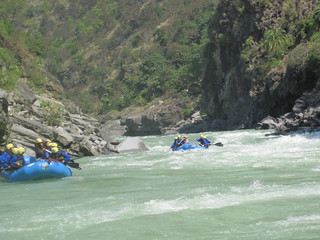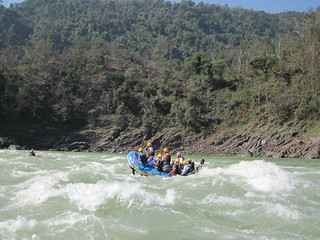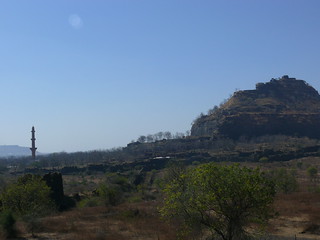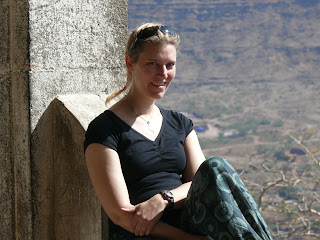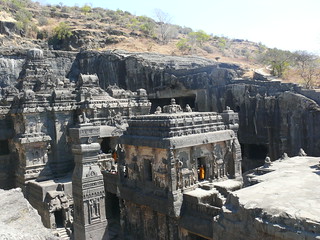How many fashion shows have I been to in my role as a high school teacher? Way more than I ever would have dreamed. Of course one probably would have been more than I ever dreamed. Last weekend brought that count up to five, or is it six? Although I will say this one was a bit more student involved then the ones in Asuncion. Four IB diploma students decided to take on the task of organizing a fashion show to benefit a NGO which works on women's rights and safety. An area in India that is increasingly coming to the worlds notice with reports on gang rapes, young girls being forced into prostitution and domestic violence. (In fact did you know that in the week following the well publicized gang rape and the subsequent death of Jyoti there were 9 more rapes reported in Delhi, and that is only in Delhi, and only the ones that were reported). What made this fashion show different? Nine students designed their own collections (okay, three collections designed by groups of three students), employed tailors to sew them, and other students to model them. The even which took place on the gardens of the Australian High Commission was a big undertaking, and provided us with an excuse to dress up for the evening, plenty to observe and perhaps a reminder of the need to choose a side in the women's right campaign that seems to be gaining strength in India.
Sunday, March 24, 2013
The benefits of fashion
How many fashion shows have I been to in my role as a high school teacher? Way more than I ever would have dreamed. Of course one probably would have been more than I ever dreamed. Last weekend brought that count up to five, or is it six? Although I will say this one was a bit more student involved then the ones in Asuncion. Four IB diploma students decided to take on the task of organizing a fashion show to benefit a NGO which works on women's rights and safety. An area in India that is increasingly coming to the worlds notice with reports on gang rapes, young girls being forced into prostitution and domestic violence. (In fact did you know that in the week following the well publicized gang rape and the subsequent death of Jyoti there were 9 more rapes reported in Delhi, and that is only in Delhi, and only the ones that were reported). What made this fashion show different? Nine students designed their own collections (okay, three collections designed by groups of three students), employed tailors to sew them, and other students to model them. The even which took place on the gardens of the Australian High Commission was a big undertaking, and provided us with an excuse to dress up for the evening, plenty to observe and perhaps a reminder of the need to choose a side in the women's right campaign that seems to be gaining strength in India.
Sunday, March 17, 2013
Rafting outside of Rishikesh
In the foothills of the Himalayas, with only a large dam to observe, we put three rafts into the Bhagirathi. A stretch of river that is remarkably isolated and untouched in heavily populated India. I did not even know that such places existed in this country. I spent three hours paddling through the white water with 19 students, 2 other teachers, and 5 guides. Untouched India. I never dreamed I'd get into that, much less thanks to school and the trips it sends the high school out on every year. This year I signed up for a rafting trip. Having never rafted I wasn't at all sure if that was a good choice, or if I it was a mistake for my first experience to be with 19 high schoolers (the answer to that is mixed...). Luckily we had a good group, some nice water, beautiful scenery, and enough rapids to satisfy those thrill seekers among us (which I'm determining is not really a word that describes me). We rafted on three separate days. Two days on the river Ganges, and for the third we headed upstream, past where the Ganges technically starts, to raft the western branch called the Bhagirathi River. One of the tributaries that joins the Alaknanda River at the confluence to form the Ganges. I'll admit I was having a great time, enjoying the scenery, our campsite, the down time and, yes, the students, until I was on the one raft that flipped over the last day headed into Rishikesh on the Golf Course rapids. I suppose it wasn't really surprising, as I did learn that the only way to get through rapids is to paddle through them (well that or float on your back while the water splashes you in the face) and with high school girls in my raft who stopped paddling as soon as they got hit by any water it was just a matter of time before we went over. I've decided to look at it as being thoroughly blessed by the river Ganges, washed clean inside and out after going completely under then swallowing a good amount of water before I could be pulled back into a raft. It just goes to show you never know what a trip will bring.
Labels:
Bhagirathi,
india,
minicourse,
Rishikesh,
school,
tourism,
travel
Location:
India
Sunday, March 10, 2013
Daulatabad Fort
You enter at the floor of the plain, climb a few steps to what must have been the outer keep as walls surround it. Past an old temple and a slightly newer mosque built to commemorate some victory. That was after handing out tickets over at the first gate - giant wooden doors complete with iron spikes to keep the elephants from crashing the door down. The path from there becomes a series of steep stone steps and right angled turns. They were not going to make it easy to get into this fort. After we passed through another set of double doors and crossed a mostly dry moat, me entered a small courtyard with a sign pointing to the dark tunnel. Dark tunnel indeed! Thank goodness for the flashlights on our phones. I am sure that this tunnel/staircase they carved out of the rock would have been pitch black without them. Even with the small light it was tricky enough to turn the correct corners and not to go into an empty side room filled with bats. I imagine it was a remarkably effective defense mechanism. When we got out of that tunnel and the slightly better lit one after it, I believe we were on the fourth (?) level of the fortification. From there you could look out over the walls to a scenery that looked remarkably like the American Southwest. You could also look over the rather steep walls hewn into the rock. Still a few more levels to go up. The next took us to a white building which I suspect was the main habitation of the fort. It had a loggia with arches that looked out over the valley. The school group that followed us up meant we didn't dwell. Another staircase around the corner led us up almost to the top. Another leveled plateau with a few remnants of building there. A single stone structure stood in the center - all that remained of our quest to make it all the way to the top. Of course you have to walk around to the backside to find the stairs, then just two short flights (scarily not against a wall this time) lead us to the penultimate height of the Daulatabad Fort to find the six meter cannon that laid there. There was definitely quite a view from the top. A few minutes to soak it in and snap a few photos then there was nothing to do but head back down - a much more painful part of the adventure for your joints. Down all those steep stairs, past the monkeys chilling in the trees, through the lighter tunnel (what you mean we could have avoided the dark one?) and on down past fragments of decoration that hinted at how the fort used to be carved. Our exploration was finished after one photo with our tuktuk driver for his album.
Labels:
Daulatabad Fort,
fort,
india,
tourism,
travel
Location:
India
Sunday, March 3, 2013
The Ellora caves
When people asked us where we were going we said "the caves," as if the Ellora and Ajanta Caves are a single entity. It's not true. They are two distinct sites relatively close to each other, albeit with a similar background. The Ellora caves pick up where the Ajanta caves left off, starting off around 600 AD. No longer are the caves solely a Buddhist thing anymore. Distinct sections of this collection of caves belong to Buddhism, Hinduism and the Jain faith. All worked on around the same time they are an early testament to religious tolerance in India.
I had no idea what to expect the second day we went out to explore the caves. I knew there were different types of caves based on religion, but somehow I expected to see something almost identical to the day before. Our guide led us into cave number 16, the largest Hindu cave, and my jaw dropped open. Literally. You make it through the entrance of what is not exactly a cave and is more a full temple carved out of the hillside to find a two story structure completely covered in detailed carvings. There are wall sections that retell stories in intricate small carvings. A lower border of elephants and lions. Numerous Hindu gods along the walls. Two pillars standing tall near the remnants of large stone elephants. Everywhere you look there is a detail that catches your eye. What is that up on top? Oh, is that a face blowing wind? I have to admit that I didn't hear much our guide said as I was too busy trying to take it all in. And that's just one cave. There are over 30 caves at Ellora. Although not all of them are as ornate. The Buddhist ones aren't too different from Ajanta, with elaborate facades and simple interiors. The main Jain temple is almost as ornate as the Hindu one, with a still standing stone elephant, two stories of initially decorated walls, numerous (naked) gods on the wall, a spacious second floor with pillars, flowers on the ceiling and more gods carved into the wall. It is actually quite amazing what people were able to do with a set off simple tools and how well they must have been able to picture a final product in their head that took over 100 years to complete.
Labels:
caves,
Ellora Caves,
india,
tourism,
travel
Location:
India
Subscribe to:
Posts (Atom)


